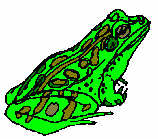
Frogs breathe through their skin, so they are particularly sensitive to environmental distress. They depend on clean water and forests throughout their life cycles, so their presence or absence tells us much about how human activities have affected the environment, especially the availability of healthy waters, the association of mature upland forest and high quality wetlands, and the presence of safe habitat linkages. At the same time, the potential for judging their presence by their songs, especially during the spring breeding season, adds to their qualification as one of the top measures of ecosystem health. If the environment is toxic, the frogs die out and their songs go with them. We know that a number of frog species have disappeared from our wetlands, and those that are left are much reduced in both numbers and distribution. This is the result of urbanization, drainage of wetlands and the discharging of sewers carrying pesticides, fertilizers and salt into streams, the lake and our remaining wetlands.
Because frogs are such an excellent sign of watershed health, the Don Watershed Regeneration Council chose them as one of eighteen key indicators for the Don Report Card. Other watershed groups are following that lead. This spring, as in other years, volunteers will move through and around marshy areas of the Toronto area listening for the trill of an American Toad or the chirp of the Spring Peeper. The collected information about the distribution and abundance of frog species, will help recognize what is needed to protect and rehabilitate our watershed’s natural areas. One of the objectives of restoring small wetlands, such as those in the Norheimer Ravine, is to bring back the frogs and toads. You may wish to be involved.
Eight frog species are known to inhabit the Don, Humber and Rouge Watersheds. Three species, American Toad, Green Frog and Leopard Frog, have been recorded throughout these watersheds. Four, Wood Frog, Chorus Frog, Spring Peeper and Gray Treefrog, were found generally in the north half and one, Bullfrog, is rare. Two other species, Mink Frog and Pickerel Frog, have been known in the Toronto area, but are now rare or extirpated. Each frog species has its own particular habitat needs and behaviour, which change through the seasons depending on whether a species is breeding or not. On moist spring nights, frogs can often be seen migrating from their wintering habitats to their breeding habitats. All species breed in wetlands but some (Wood Frog, Spring Peeper, Gray Treefrog) will spend most of their time, summer and winter, in upland forests. So the corridors between these habitats must provide safe travels to and from. Bullfrogs are the least migratory species. Frogs can be seen anytime but hearing the different species is another story. Since they breed at different times, knowing when to listen for them and how to recognize their calls are necessary skills.
To learn more about frogs, their songs and how to recognize them go to Frog Watch.

